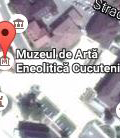
E-learning

The Cucuteni-Tripolye Culture represents the most important European prehistoric civilization, based on the high level of (pre-urban) development attained. It is also the last cultural manifestation of the East-European Neo-Eneolitic, with a long evolution, lasting between 5000-3500 B.C., and unfolding during the Atlanic geoclimatic time period, which was characterized by a warmer and more humide climate, of a subtropical (Mediterranean) type, thus differing from the current moderate-continental climat, which is colder and drier.
Its human communities, characterized by a more sedentary, agricultural lifestyle, have occupied a very vast area, between the Transylvania Olt and Dnieper rivers, mostly overlapping the SubCarpathian region and the Moldo-Volhyno-Podolian Plateau, on the current territories of Romania, the Republic of Moldova and the Ukraine. This is also the last population of pre-Indo-European origin from Eastern Europe.
The name of this brilliant continental civilization originates from the Cucuteni and Trypolye localities (the former from Iași county, Romania and the latter from the proximity of Kiev, Ucraine), where its vestiges have been discovered at the end of XIX century.
Remarkable for the spectacular aspect, quantity, quality and diversity of its vestiges, the Cucuteni-Tripolye Culture has always drawn the attention of both specialists and the broader public, and thus, after more than 130 years of investigations, it enjoys the well-earned status of the most intensely researched, highlighted and rated prehistoric civilization that has evolved on the current territory of Romania.
In the vast area occupied by this civilization over 5000 settlements have been discovered up to date. Some of these possess surface areas of hundreds of hectares, with thousands of buildings (annexes, dwellings, workshops, sanctuaries) disposed according to pre-defined plans (groups, rows, circles), which probably hosted several thousand inhabitants. Others were provided with more or less complex fortifications such as moats, palisades or fences.
The most spectacular and valued artifacts of this civilization are obviously the prestige objects, manufactured by artisans specialized in their domains, possessing both artistic and cultic and representing authentic masterpieces of decorative and prehistoric figurative art. Representative of these are the vases with stands and small columns, the crown vases, the miniature models of sanctuaries, the “binoculars” shaped vases, the “hora” vases, and the treasures composed of adornment objects.
Among this civilization’s distinctive features we note the intentional burning (in the majority of cases) of buildings within the settlements, as well as the total absence of the necropoles, the dead being probably incinerated.
The end of the Cucuteni-Tripolye Culture was brought about by a complex of natural and anthropic factors which put an end to the sedentary and agricultural lifestyle of its communities.
